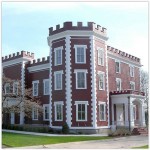 Fort Totten is a former United States Army installation in the New York City borough of Queens. It is located on the north shore of Long Island, on a peninsula.Fort Totten is at the head of Little Neck Bay, which is also the place where the East River widens to become Long Island Sound. While the U.S. Army Reserve continues to maintain a presence at the fort, the property is now owned by the City of New York.
Fort Totten is a former United States Army installation in the New York City borough of Queens. It is located on the north shore of Long Island, on a peninsula.Fort Totten is at the head of Little Neck Bay, which is also the place where the East River widens to become Long Island Sound. While the U.S. Army Reserve continues to maintain a presence at the fort, the property is now owned by the City of New York.
HISTORY
Construction began on Fort Totten in 1862 after the land was purchased by the U.S. Government in 1857 from the Willets family. The fort is close to the Queens neighborhoods of Bay Terrace, Bayside, Beechhurst and Whitestone. The original purpose was to protect the East River approach to New York Harbor, along with Fort Schuyler, which faces it from Throggs Neck in the Bronx on the opposite side of the river entrance. The fort was named in 1898 after Joseph Gilbert Totten.
In 1954, the fort became a Project Nike air defense site. Although no missiles were located at Fort Totten, it was the regional headquarters for the New York area; administrative offices and personnel housing was located at the fort. Fort Totten was also the headquarters for the 66th Anti-Aircraft Missile Battalion, Battery D, whose missiles were located at nearby Fort Slocum on Hart Island. Headquarters of the 41st AAA Gun Battalion was also stationed here. 90MM cannon Batteries of the 41st were located throughout Long Island. During the mid-1950s the 90 MM guns were replaced with Nike missiles. This use of Fort Totten was discontinued in 1974.
Reliable rumor has it, as well, that Fort Totten was the locale of the safe house where Joe Valachi (Genovese family mob turncoat and subject of a later book “The Valachi Papers”) was hidden away in 1970 until taken away to a Federal prison in Texas where he died in 1971.
Much of the fort has become a public park and is open for tours by the New York City Department of Parks & Recreation. It is accessible by the Cross Island Parkway and Brooklyn-Queens Greenway. The Fort Totten Visitor’s Center has been refurbished and houses a museum with exhibits about the history of Fort Totten.
Parts are used by the New York Police Department and the New York Fire Department as a training center.
During the winter months, a large variety of migratory waterfowl can be observed in the surrounding waters: Little Bay to the west, Long Island Sound to the north, and Little Neck Bay to the east. Most buildings are dilapidated and unused. Fort Totten is also a sports complex, with an outdoor pool, baseball fields and three soccer fields used for youth soccer.
The Fort Totten Officers’ Club, known as “the Castle,” is home to the Bayside Historical Society, which hosts events, historic exhibitions and cultural programs. It was listed on the National Register of Historic Places in 1986.
The Officer’s Club can be clearly seen in the closing scene of an April 2009 episode of the TV series Fringe, filmed at the Fort, in which the FBI delivers to an undisclosed location a child found to have been sealed for years in a building vault.
The Officer’s Club and the fort are shown in Blue Bloods season 4, episode 13 where detectives track down Fort Totten soldier who is suffering from PTSD.
The fort was used as a filming location for the season 5 finale of the TV series White Collar in which a valuable treasure may be hidden at the fort.
The Fort is a New York City Historic District and the Club a Designated Landmark. The club building was apparently designed by Robert E. Lee in his pre-Civil War capacity as a military engineer, although some historians believe that the actual design was done by a subordinate and merely approved by Lee. The building was designed in the neo-Gothic style popular at the time and was not created specifically for Fort Totten but rather was a generic design approved by the Army for use at military installations. Identical structures were built at other Army forts and the Castle design was adopted by the U.S. Army Corps of Engineers as their insignia, although the reason for this action is murky. A local tradition is that the Corps of Engineers symbol derived from the Fort Totten building, but the reverse is more likely: the building design was based on a Castle in part because this symbol had long been identified with Army engineers. When Fort Totten’s Castle was restored in the 1990s, the Corps of Engineers was contacted in the hope that they would participate, particularly since the Fort Totten Castle was occupied at one time by the Corps of Engineers, but the military failed to show any interest.

